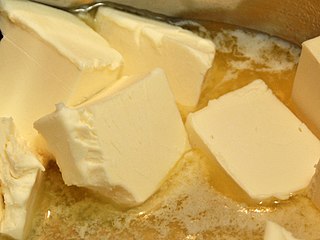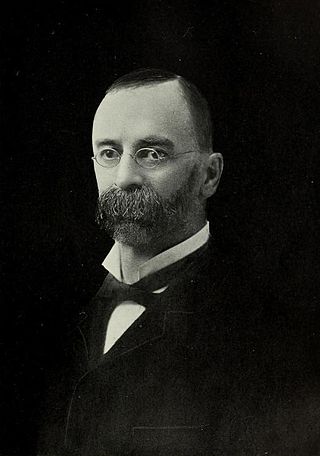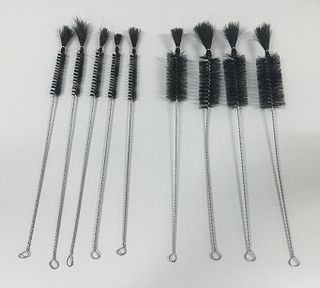

The Babcock test is an inexpensive and practical procedure to determine the fat content of milk. It is named after its developer, Stephen M. Babcock (1843–1931), professor at the University of Wisconsin. [1] [2] [3]


The Babcock test is an inexpensive and practical procedure to determine the fat content of milk. It is named after its developer, Stephen M. Babcock (1843–1931), professor at the University of Wisconsin. [1] [2] [3]
The bottle and the test were developed by Stephen Babcock in 1890 as a simple but accurate way to detect adulterations practiced by some dairy farmers, including diluting the milk with water or skimming some cream. [3]
The test was quickly adopted by dairymen, and also by farmers to help the breeding of milk cows. [3] The tests were usually done monthly by an employee of the local Dairy Herd Improvement Association.[ citation needed ] Babcock's refusal to patent his process or the device greatly helped its widespread diffusion. [4] [5]
In 1911, the American Dairy Science Association's Committee on Official Methods of Testing Milk and Cream for Butterfat, chaired by O. F. Hunziker, met in Washington DC with the Dairy Division of the USDA, the U.S. Bureau of Standards and manufacturers of glassware. [6] As a result of those talks, the procedure and the special glassware were standardized by the US government in 1917. [7] [8] Additional specifications were published by the Association of Official Agricultural Chemists (now AOAC International) in 1927. [9]
The test is based on the observation that a suitable amount of sulfuric acid added to the milk will dissolve proteins and other components, except the fat. Heating and centrifuging cause the fat to separate and float to the top, in a layer free of bubbles. The amount of fat in the milk can then be estimated from the volume of that layer. The procedure was commonly carried out in a special flask with a long neck, called a Babcock bottle. [1]
Specifically, the test consisted of the following steps: [6] [7] [8]
The scale on the neck was calibrated so as to give a direct readout of the percentage of fat in the original sample (assumed to be 17.6 mL), in 0.1 percent increments, without the need for computation. [6]
The original Babcock test was not suitable for estimating the fat contents of ice cream, since the sugar and other ingredients would be charred by the sulfuric acid and contaminate the fat layer. After thousands of experiments, a modified test, suitable for the purpose, was developed in 1930 by L. K. Crowe at the University of Nebraska. It used a solution of ammonium hydroxide in N-butyl alcohol, and a mixture of sulfuric acid and ethanol. [10]

Cream is a dairy product composed of the higher-fat layer skimmed from the top of milk before homogenization. In un-homogenized milk, the fat, which is less dense, eventually rises to the top. In the industrial production of cream, this process is accelerated by using centrifuges called "separators". In many countries, it is sold in several grades depending on the total butterfat content. It can be dried to a powder for shipment to distant markets, and contains high levels of saturated fat.

Butter is a dairy product made from the fat and protein components of churned cream. It is a semi-solid emulsion at room temperature, consisting of approximately 80% butterfat. It is used at room temperature as a spread, melted as a condiment, and used as a fat in baking, sauce-making, pan frying, and other cooking procedures.

Buttermilk is a fermented dairy drink. Traditionally, it was the liquid left behind after churning butter out of cultured cream. As most modern butter in western countries is not made with cultured cream but uncultured sweet cream, most modern buttermilk in western countries is cultured separately. It is common in warm climates where unrefrigerated milk sours quickly.

Decantation is a process for the separation of mixtures of immiscible liquids or of a liquid and a solid mixture such as a suspension. The layer closer to the top of the container—the less dense of the two liquids, or the liquid from which the precipitate or sediment has settled out—is poured off, leaving the other component or the denser liquid of the mixture behind. An incomplete separation is witnessed during the separation of two immiscible liquids. To put it in a simple way, decantation is separating immiscible materials by transferring the top layer to another container. The process does not provide accurate or pure product.

Dairy cattle are cattle bred for the ability to produce large quantities of milk, from which dairy products are made. Dairy cattle generally are of the species Bos taurus.

The Brown Swiss or American Brown Swiss is an American breed of dairy cattle. It derives from the traditional triple-purpose Braunvieh of the Alpine region of Europe, but has diverged substantially from it. It was selectively bred for dairy qualities only, and its draft and beef capabilities were lost. Milk yield was measured in 2013 at 10231 kg (22600 lb) per year; the milk has about 4% butterfat and 3.5% protein and is suitable for making cheese.

Stephen Moulton Babcock was an American agricultural chemist. He is best known for developing the Babcock test, used to determine butterfat content in milk and cheese processing, and for the single-grain experiment that led to the development of nutritional science as a recognized discipline.

Crème fraîche is a dairy product, a soured cream containing 10–45% butterfat, with a pH of approximately 4.5. It is soured with a bacterial culture. European labeling regulations specify the two ingredients must be cream and bacterial culture. It is served over fruit and baked goods, as well as being added to soups and sauces. It is used in a variety of other recipes. Sour cream is a similar foodstuff, except that crème fraîche is less sour and has a higher fat content. Sour cream may contain thickening agents not permitted in crème fraîche in many jurisdictions.
Elaidic acid is a chemical compound with the formula C
18H
34O
2, specifically the fatty acid with structural formula HOOC−(CH2)7−CH=CH−(CH2)7−CH3, with the double bond in trans configuration. It is a colorless oily solid. Its salts and esters are called elaidates.
The American Dairy Science Association (ADSA) is a non-profit professional organization for the advancement of dairy science. ADSA is headquartered in Champaign, Illinois.
In chemistry, the terms volatile acid and volatile acidity (VA) are used somewhat differently in various application areas.
Κ-casein, or kappa casein, is a mammalian milk protein involved in several important physiological processes. Chymosin splits K-casein into an insoluble peptide and water-soluble glycomacropeptide (GMP). GMP is responsible for an increased efficiency of digestion, prevention of neonate hypersensitivity to ingested proteins, and inhibition of gastric pathogens. The human gene for κ-casein is CSN3.

Otto Frederick Hunziker was a pioneer in the American and international dairy industry, as both an educator and a technical innovator. Hunziker was born and raised in Switzerland, emigrated to the U.S., and studied at Cornell University. He started and developed the dairy program at Purdue University when such programs were at their infancy. At this same time, Hunziker was heavily involved with the development of the American Dairy Science Association (ADSA) and the standardization and improvement of many dairy tests and processes. Hunziker wrote several of the leading dairy processing texts, which continue to be cited. After leaving Purdue University, Hunziker managed research and operations at a large, national condensary, continued to drive ADSA's standardization and publishing efforts, represented the U.S. at international dairy congresses, and facilitated dairy industry improvements across the globe.

The fat content of milk is the proportion of milk, by weight, made up by butterfat. The fat content, particularly of cow's milk, is modified to make a variety of products. The fat content of milk is usually stated on the container, and the color of the label or milk bottle top varied to enable quick recognition.
Charles Roy Henderson was an American statistician and a pioneer in animal breeding — the application of quantitative methods for the genetic evaluation of domestic livestock. This is critically important because it allows farmers and geneticists to predict whether a crop or animal will have a desired trait, and to what extent the trait will be expressed. He developed mixed model equations to obtain best linear unbiased predictions of breeding values and, in general, any random effect. He invented three methods for the estimation of variance components in unbalanced settings of mixed models, and invented a method for constructing the inverse of Wright's numerator relationship matrix based on a simple list of pedigree information. He, with his Ph.D. student Shayle R. Searle, greatly extended the use of matrix notation in statistics. His methods are widely used by the domestic livestock industry throughout the world and are a cornerstone of linear model theory.
The Gerber method is a primary and historic chemical test to determine the fat content of substances, most commonly milk and cream. The Gerber method is the primary testing method in Europe and much of the world. The fairly similar Babcock test is used primarily in the United States, although the Gerber method also enjoys significant use in the U.S. as well.

Lore Alford Rogers was an American bacteriologist and dairy scientist. He is credited with discovering that butter made from pasteurized sweet cream remained fresher than that made from sour ripened cream, while suggesting that surplus milk could still be sold as concentrated sour milk products. He refined the steps for manufacture of high quality Swiss cheese and, new to the United States, production of Roquefort cheese. He was instrumental in finding ways to discourage fungal growth in sweetened condensed milk and preventing losses in evaporated milk from heat coagulation.

A test tube brush or spout brush is a brush used for cleaning test tubes and narrow mouth laboratory glassware, such as graduated cylinders, burettes, and Erlenmeyer flasks. It is composed of nylon, synthetic, or animal fur bristles of various diameters lined against a rather sturdy wire handle with a looped end for hanging. The wire can be made from a wide range of metals, such as aluminium, bronze, beryllium, copper, and brass. FDA grade brushes are designed to be resistant to acid and other corrosive chemicals, including aromatic and aliphatic hydrocarbons, ketones, ethyl acetate esters, and trichloroethylene.

A Babcock bottle is a clear glass flask with a long graduated neck, used in the Babcock test to evaluate the cream contents of milk. It is also called a Babcock milk test bottle, milk test bottle, cream test bottle, and other similar names.
Louis Firth Nafis was an American entrepreneur and inventor, best known as the first manufacturer of the standard Babcock milk test bottle. He was born in Jersey City, New Jersey on November 1, 1884, and died on February 26, 1955, in Evanston, Illinois.